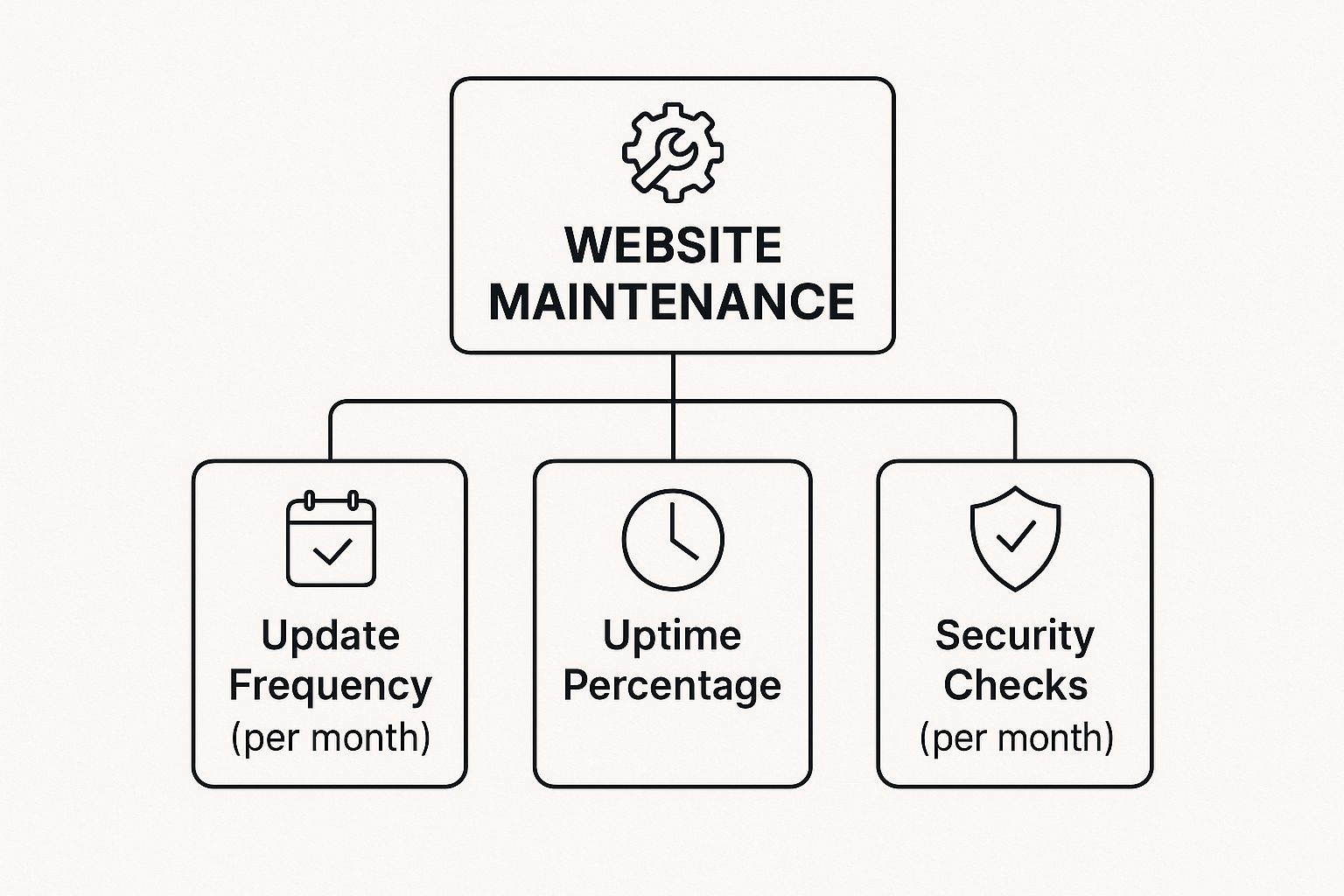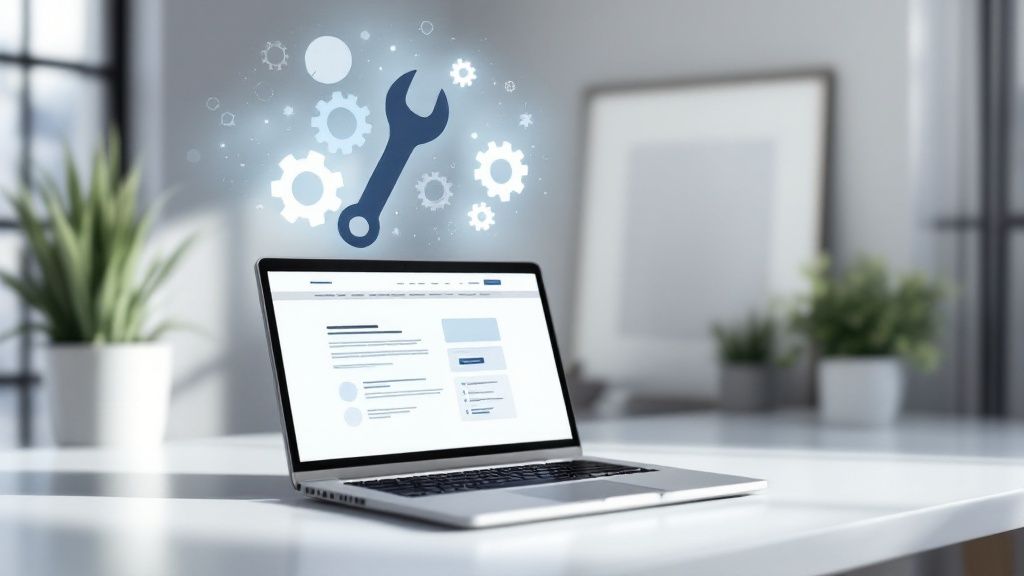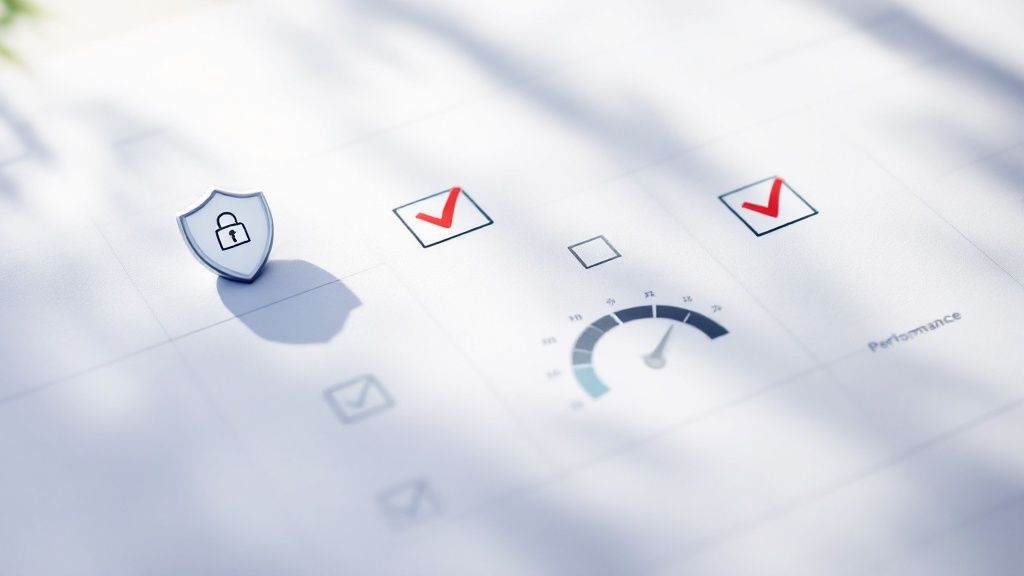What Is Website Maintenance Explained Simply
This article was assisted with AI. We may include links to partners.
Think of your website like a car. You wouldn't drive it for years without changing the oil, rotating the tires, or getting a tune-up, right? Of course not. Your website needs that same kind of regular attention to keep it running smoothly, securely, and effectively. That, in a nutshell, is website maintenance.
It’s the ongoing process of checking your site for any issues, applying necessary updates, and making sure everything is secure and performing at its peak. This isn't a one-and-done task you check off after launch; it's a continuous effort to protect your digital investment.
Neglecting maintenance is like ignoring a car's "check engine" light. Sooner or later, you’re going to break down, and it's almost always at the most inconvenient time. A proactive approach keeps you in control and ensures your visitors always have a great experience.
The Three Pillars of Website Maintenance
To really understand what website maintenance involves, it helps to break it down into three core areas. Think of them as the three pillars of a strong building—if one is weak, the whole structure is at risk. Each one is essential for protecting your digital presence and supporting your business goals.
Let's quickly run through what they are and why they matter.
| Pillar | What It Means (In Simple Terms) | Why It Matters for Your Business |
|---|---|---|
| Security | Protecting your site from hackers, viruses, and data thieves. | It builds trust with your customers and protects their sensitive information (and yours!). |
| Performance | Making sure your website loads lightning-fast and works without glitches or errors on all devices. | A snappy, reliable site improves user experience and gives your SEO rankings a nice boost. |
| Health | General housekeeping: keeping your software, content, and backups fresh and organized. | It's crucial for preventing bugs, avoiding catastrophic data loss, and making sure you're not showing outdated info. |
When you look at it this way, it’s clear that maintenance isn't just a technical chore. It’s a fundamental business practice that directly impacts your reputation, customer satisfaction, and bottom line.
This infographic does a great job of visualizing the key activities that keep a site healthy, from update frequency to uptime percentages.

As you can see, a well-oiled website requires consistent checks and updates to stay secure and dependable for your visitors.
Why Neglecting Your Website Costs You More

Putting off website maintenance seems like an easy way to save time and money. But it's a gamble that almost never pays off.
Think of it like ignoring a tiny leak in your roof. It seems harmless at first. Before you know it, you’re dealing with major water damage that costs a fortune to repair. Your website works the same way. The consequences of neglect aren't just technical glitches—they hit your bottom line, hard.
A slow, buggy, or insecure website is a fast track to losing customer trust. When visitors run into broken links or pages that take forever to load, they don't stick around. In fact, just a one-second delay in page load time can slash your conversions by 7%.
The High Price of Inaction
When you let routine upkeep slide, you’re welcoming serious problems that can cripple your business. Every little issue creates a ripple effect, hurting everything from your brand’s reputation to your monthly sales numbers.
Here are the three biggest costs you'll face:
- Security Breaches: An unmaintained site is an easy target. Outdated software and plugins are full of known security holes that hackers actively search for. A single breach can mean stolen customer data, a trashed reputation, and huge recovery costs. Actionable Tip: Get a head start by exploring some fundamental website security best practices and implementing at least one today, like using strong, unique passwords for your admin accounts.
- Poor SEO Rankings: Search engines like Google favor websites that are fast, secure, and easy to use. A neglected site bogged down by errors and slow performance will inevitably sink in search rankings, making it much harder for new customers to find you.
- Lost Customers and Revenue: Every 404 error page (page not found) or broken contact form is a missed opportunity. A clunky user experience doesn't just frustrate visitors; it sends them straight to your competitors, and they probably won't be back.
Ultimately, proactive website maintenance isn't an expense—it's an investment. It protects your digital storefront, ensures a smooth customer journey, and secures your position in a competitive market. It’s the ongoing work that turns a simple website into a reliable business asset.
Your Essential Website Maintenance Checklist

Now that you understand why website maintenance is a big deal, let's turn that knowledge into a simple, practical to-do list.
I’ve broken down the must-do tasks into weekly, monthly, and quarterly chunks. Think of it as a fitness routine for your website—it keeps everything in top shape and ensures nothing critical gets overlooked. Stick to this schedule, and you’ll proactively keep your site secure, speedy, and dependable.
Your Weekly Tune-Up Tasks
These are the quick checks that stop tiny glitches from turning into massive headaches. Consistency is everything here.
- Perform Full Website Backups: This is your ultimate "undo" button. If something goes wrong, a recent backup lets you restore your site in minutes, not days. Actionable Tip: Most hosting providers offer automated backup tools. Log in to your hosting control panel and schedule backups to run automatically at least once a week.
- Update Software and Plugins: Developers constantly release updates with crucial security fixes and performance improvements. Applying them right away closes security gaps that hackers look for.
- Check for Broken Links (404 Errors): Broken links create dead ends for your visitors. Actionable Tip: Use a free online tool like "Broken Link Checker" to scan your site. Find any broken links and either fix the URL or remove the link.
Your Monthly Health Check
Once a month, it's time to dig a little deeper. These tasks are all about performance and optimization.
A slow website is a business killer. Studies show that 47% of consumers expect a webpage to load in two seconds or less. Monthly speed checks are the only way to meet that expectation.
Actionable Tip: Use a free tool like Google's PageSpeed Insights. Just enter your website's address, and it will give you a speed score and tell you exactly what's slowing it down. Next, clean up your database. Over time, your site's database (where all your content and settings are stored) collects junk data that can slow it down. Many website platforms, like WordPress, have plugins that can clean this up for you with just a few clicks.
Your Quarterly Strategic Review
Every three months, it’s time to look at the big picture and make sure your website is still aligned with your business goals.
- Test All Forms: Fill out every contact form, booking form, and newsletter signup on your site. A broken form is a lost lead. Actionable Tip: Set a calendar reminder to do this every 90 days.
- Review Your SEO Performance: Log into your analytics (like Google Analytics). See which pages are most popular and which keywords people are using to find you. Are you ranking for the keywords you’re targeting?
- Assess Your Hosting Plan: As your business grows, your hosting needs will change. Check your hosting plan to ensure it still provides the speed and security you need. It’s worth exploring the best website hosts for businesses to see if it’s time for an upgrade.
How Much Should Website Maintenance Cost?
Sooner or later, every business owner asks: "What's this going to cost me?" For website maintenance, there's no single price tag. The cost depends on how complex your website is.
Maintaining a simple blog is like the routine upkeep for a small car. Managing a large e-commerce store with thousands of products is like servicing a fleet of trucks. The more features, traffic, and transactions you have, the more attention your site will need.
Factors like your website's size, the technology it’s built on (like WordPress or Shopify), and the level of support you require all play a role. Your approach—whether you handle it yourself, hire a freelancer, or partner with an agency—will also make a big difference in your budget.
Breaking Down the Numbers
For a typical small business website, you can expect monthly maintenance costs to fall somewhere between $35 and $500. This range usually covers the essentials: your domain name, hosting, security certificates, and routine tasks like backups and software updates.
E-commerce sites almost always sit at the higher end of that spectrum because they have more complex security needs and payment systems to manage.
It's crucial to remember that website maintenance costs are completely separate from the initial price of building your site. The first is a one-time investment; the second is an ongoing operational expense.
To give you a clearer picture, here’s a rough breakdown of what different types of websites might cost to maintain each month.
Estimated Monthly Website Maintenance Costs
This table breaks down the typical monthly investment you can expect based on your site's complexity. These are just estimates, but they provide a solid starting point for your budget.
| Website Type | Typical Monthly Cost Range | Key Services Included |
|---|---|---|
| Personal Blog | $25 – $75 | Hosting, domain, basic updates, backups. |
| Small Business | $75 – $500 | All the basics plus security scans, performance monitoring. |
| E-commerce Store | $250 – $4,500+ | Advanced security, payment gateway support, uptime monitoring. |
Keep in mind that these ongoing fees are just one piece of the puzzle. To see how they stack up against the initial build, be sure to check out our guide on how much a website costs in 2025.
Choosing Your Path: DIY vs. Professional Services

When it comes to keeping your website in top shape, you have two main options: do it yourself or hire an expert. There's no single "right" answer. The best path depends on your budget, your comfort with technology, and how much time you can spare.
Think of this as a strategic business decision. Let's break down both options.
The Do-It-Yourself Approach
Going the DIY route is tempting, especially when you're watching every penny. The biggest win is the cost savings—you're trading your time and effort to keep more cash in your pocket. Plus, it gives you total control.
But the DIY path comes with a learning curve. You’ll need to set aside time to get comfortable with technical tasks, from updating plugins to running security scans. It can easily become a bigger time commitment than you expect.
Actionable Tip: Tools like the Solo AI Website Creator are built to make this process easier. They provide a straightforward dashboard that simplifies tasks like updating content or checking performance, lowering the technical bar for business owners who want to stay hands-on.
Hiring Professional Services
Opting for a professional maintenance service is like hiring a specialist to manage your website's health for you. The immediate payoff is peace of mind. You get to focus your energy on running your business, knowing a pro is keeping your site secure, speedy, and online.
Handing over maintenance to a pro isn't just about saving time; it’s about gaining expertise. Professionals can often spot and prevent issues you might not notice until it’s too late.
This route costs more upfront, but you're really buying time and reliability. Professionals handle everything from tricky bug fixes to sophisticated security monitoring.
So, which should you choose?
- Choose DIY if: You have more time than money, you enjoy learning new tech skills, and your website is straightforward (like a simple blog or portfolio).
- Choose Professional Services if: Your time is better spent on growing your business, you have a more complex site (like an e-commerce store), or you want the assurance that an expert has your back.
How AI Is Changing Website Maintenance
Website maintenance isn't just about running through a manual checklist anymore. AI is shifting it from a routine chore to a smart, automated strategy that works for you 24/7.
It's like upgrading from a simple security camera to an intelligent system that doesn't just record what happens but actively predicts and prevents problems.
AI-powered tools can keep a constant eye on your website, flag suspicious activity, and even block threats before they do any harm. They're also smart enough to fine-tune your site’s performance, making sure it’s always loading as fast as possible.
Predictive Power And Automation
The real game-changer is predictive maintenance. Instead of waiting for something to break, AI algorithms analyze patterns in your site's performance and traffic. This allows them to spot potential trouble—like a server about to get overloaded—before it happens. This proactive approach is huge for preventing costly downtime.
Artificial intelligence is central to modern website maintenance. AI can analyze traffic patterns and spot unusual behavior far faster than any human. Considering that nearly 60% of web traffic is just automated bots, having real-time threat detection is a must.
AI is also taking over other critical tasks. It can help generate SEO-friendly content, which is a massive help in keeping your site fresh. Actionable Tip: You can check out a few clever ways to use AI text generators to beef up your content game.
It's also completely changing customer support. For a closer look, you can see how businesses are automating customer service with AI. This shift means less tedious manual work for you and a more secure, high-performing website for your audience.
Got questions about website maintenance? You're not alone. Here are the answers to a few common ones we hear from business owners.
How Often Should I Perform Website Maintenance?
This depends on your website. A simple blog might just need a check-in once a month. But a busy e-commerce store with constant orders needs weekly, if not daily, monitoring.
Actionable Tip: A great rule of thumb is to handle small tasks—like backups and software updates—every week. Then, set aside time once a month for deeper dives, like performance reviews and security scans.
Can I Do Website Maintenance Myself?
Absolutely! For basic tasks like adding a blog post or changing a photo, most modern platforms make it easy.
But when you get into more technical tasks—like running security scans, cleaning up a database, or optimizing site speed—it often requires specific skills. Actionable Tip: Using an intuitive platform like the Solo AI Website Creator can take a lot of that complex work off your plate, simplifying your responsibilities.
Think of it like this: your web hosting is the plot of land you rent. Your website is the house on that land. Website maintenance is all the upkeep that keeps your house from falling apart. You’re fixing leaky faucets (broken links), testing the smoke alarms (security scans), and maybe giving it a fresh coat of paint (content updates). This isn't just about having a website; it's about making sure the lights are on and the doors are open for every visitor.
Ready to stop worrying about the technical details and get back to running your business? Let the Solo AI Website Creator handle the heavy lifting. You can build and manage a professional, secure, and fast website without breaking a sweat. Get started for free today.
